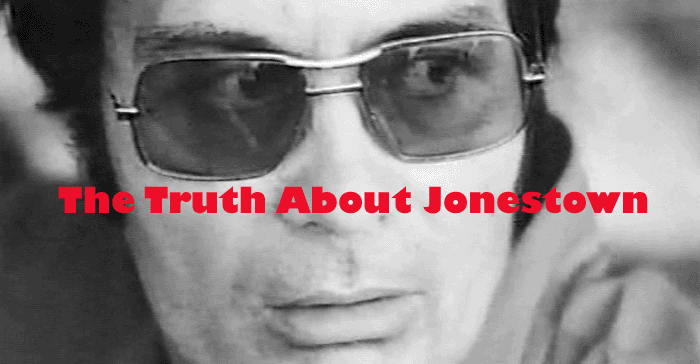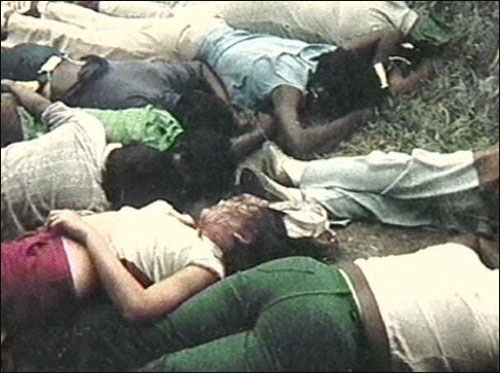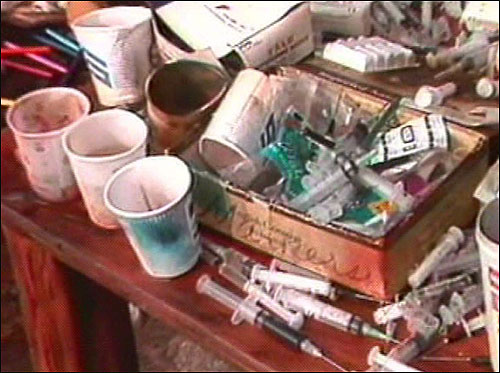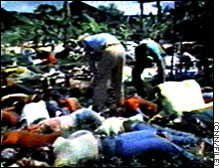

Where were the others cult members?
But how can this be? How could 408 bodies, discovered at first count, be able to cover 505 bodies for a total of 913? Also, is it possible that those who first worked on the bodies, punching holes to release the gas, would likely miss bodies lying beneath each other? Further, 82 of the bodies first found and reported were children. How could these bodies have hidden other beneath them? A careful examination of nearly 150 photographs, aerial and close-up, fails to show even one body lying under another.
 As it turns out, the first reports were likely true. About 400 people had died, and about 700 had escaped to the jungle. It was reported that American authorities had searched unsuccessfully for the 700 people who were missing. They were soon joined by at least a hundred Guyanese troops who were ordered to search the jungle for any survivors. Coincidentally, nearly 600 British Black Watch comandos were on "training exercises" in this same area and joined in the search. Then, as if these were not enough, American Green Berets were on site as well. The presence of all these soldiers, trained in covert killing operations, perhaps can explain the hundreds of additional bodies that were eventually counted around the pavillion. How did the other cult members die? Photographs taken at the site show most of the bodies lying in neat rows, face down. Close-ups reveal linear drag marks. It is as though the bodies were brought there and positioned by someone after death. This leads to the horrible thought that almost 700 people, mostly Black and many women and children, could have been tracked down in the surrounding jungle, executed, and then carefully added to the original pile of bodies. If this did happen then it should be easy to prove by determining the actual cause of death: cyanide ingested kool-aide or some other method. Dr. Mootoo was the top Guyanese pathologist at the time and was at the Jonestown site within a few hours. He accompanied the Guyanese who initially counted the bodies and punctured them. He examined them to see their cause of death. His professional opinion was that most deaths were NOT caused by cyanide laced kool-aid.
 Forensic scientists recognize certain physical signs that suggest a particular cause of death, such as poisoning. Cyanide in a nerve blocking agent. It stops all neural activity to such vital organs as the heart and lungs and scrambles nerve messages to the muscles. Muscles twitch and contract making the death an unusually painful one. The diaphram muscles cease to function, causing loss of breathing and eventually the heart fails to pump, resulting in death. Muscles in the face likewise contract, causing what pathologists call "cyanide rictus," or the "deadly grin." Dr. Mootoo saw none of these signs in the bodies at Jonestown. Instead, the victims appeared to lie in a relaxed position with normal muscle tone. These bodies, in his opinion, did NOT die from ingesting cyanide. What Dr. Mootoo did find was just as significant. About 80-90% of the victims had needle marks from a hypodermic syringe in their upper shoulder, as if administered from behind. Others had been shot or strangled. Many exhibited ligature marks or other signs of having been restrained just prior to their death. Several photographs clearly showed gun shot wounds. Who could have done this? Also, although reports stated that Jim Jones, the cult leader, had committed suicide, the gun that killed him was found nearly 200 feet from his body! Dr. Mootoo, acting in the capacity of Chief Medical Examiner at the Guyanese grand jury investigation concluded that, "All but three of the people were murdered by "persons unknown." Only two had committed suicide they said. Despite this startling evidence, Lt. Col. Schuler,the U.S. Army spokesman said, "No autopsies are needed. The cause of death is not an issue here." A Cover-Up. But Of What? John Judge, in his article, "The Black Hole of Guyana" (1985), states:
 [Above: Jones is handed a note by Ryan that was passed to him by members seeking to leave with the Congressman. This upsets Jones who then apparently gives orders for the murder to supress the truth of what was really going on in Jonestown.] The badly decomposed bodies were sent to Dover, Maryland for autopsies, but their poor condition made it impossible to determine their exact cause of death. Not everyone was quiet about the lack of forensic procedure enacted by the American military.The President of the National Association of Medical Examiners, in an open letter to the U.S. military, called the whole operation "badly botched." He noted that by sampling the blood or body fluids on the site, the cause of death could have confirmed or ruled out cyanide, yet this was never attempted. These military doctors who attempted these autopsies were totally unaware of Dr. Mootoo's conclusions. Characterizing the Guyanese grand jury findings, American officials simply said they had uncovered "few facts." John Judge further writes:
 Richard Dwyer was a known CIA agent who accompanied Ryan on his fact finding trip. He is seen [Above] in a film of Ryan's departure securing his boarding pass. Later [Above] he can be seen accompanying Ryan to the small plane before the murders of Ryan and other members of the team. He mysteriously separates away from the group just before the shooting begins. Just as mysteriously, he was not a target. It is believed that Dwyer was aware of the impending massacre and had a special relationship with Jones. A tape found at the camp recorded the voice of Jones telling his guards, "Get Dwyer out of here before something happens to him." Later, a radio transmission on a special CIA frequency reported the massacre -- a transmission believed made by Dwyer after he terminated Jones. Who Was Jim Jones? Jim Jones spent his youth in Lynn, Indiana. Some have described him as a loner, yet he was not shy about public speaking and seemed to enjoy immitating preachers and giving testamony about the Bible. These were perhaps early indications that Jim had a pension for ruling the pulpit. It is important to note that he had one special childhood friend named Dan Mitrione. This friend would later play an important role in Jim's future. Jim finally realized his dream and was ordained to a Christian ministry in the 1950s. He also met and married his lifelong companion, Marceline. To supplement his income as a minister, Jim sold pet monkeys that he purchased from the research department at Indiana State University. Supposedly, these monkeys had been used for experiments and were later of no use to researchers. The irony of this will also become evident in Jim's future. Jim's work as a minister resembled a side show. He would operate from a tent and pretend to heal people of all types of illnesses, often showing raw chicken livers and claiming they were "cancers" he had removed by "divine power." He perhaps would have been tarred and feathered but for the intervention of the local police chief and close childhood friend, Dan Mitrione. His landlady described Jim at that time as "a gangster who used a Bible instead of a gun." The next chapter in Jim Jones' life again involved Dan Mitrione who had graduated from being a police chief to join the CIA-financed International Police Academy. Mitrone was trained there in counter-insurgency and torture techniques. Somehow, at about the same time, Jones, barely able to support his family as a fake "healer," was financed to move his family to Brazil and minister to the Brazilians -- despite the fact that he spoke no Portugese! In Brazil, Jim and his family occupied a large apartment in an upscale neighborhood and always seemed to have ample food and cash. Instead of preaching, he told neighbors he worked with U.S. Navy Intelligence and that his income was provided by the U.S. Embassy. Those close to Jim Jones in Brazil claim that he was secretly studying the mind control techniques of Voodoo cults and religions, such as Santa Ria, which still control thousands of followers in South America. These occult religions are known to utilize fake healings, exotic rituals and even drugs to manipulate and control their followers. Remember Dan Mitrone? Coincidentally he was also in Brazil, not far from Jones. During this period he working with the CIA, teaching interrogation and torture techniques. He would later be kidnapped and killed by Tupermaro guerillas in Uruguay. Shortly after Mitrone's demise, in 1963, Jones returned to the United States with $10,000 -- a large amount of cash at the time. He used the money to establish the first People's Temple in Ukiah, California, in 1965. He then established a rest home with the ironic name of "The Happy Havens Rest Home" and began to attract the elderly, people from other rest homes, psychiatric patients, foster children and prisoners -- the down-trodden of society. He appeared to be assembling a large population of individuals, all with few family or social attachments -- people that nobody cared about or would miss... But for what?
Those who "joined" Jones' Peoples Temple found it hard or impossible to leave. Jones surrounded himself with an entourage of armed guards, dressed like Gestapo in leather boots. New members were "persuaded" to turn over all of their possessions to the church. To demonstrate their loyalty they were asked to sign blank pieces of paper and to make confessions which would be used against them if they tried to leave. Since members had no family ties and few options after they lost their homes, most stayed with the People's Temple out of necessity and fear.

 |
 During the first press conference, the Americans asserted that the initial errors were because the Guyanese "could not count." The Guyanese had the gruesome task of counting the bodies as they lay festering in the hot, tropical heat. They later were asked to assist the American troops by systematically poking holes in the flesh to release gas formed by the decay, thus preventing the bodies from exploding. Then another theory was given by the Americans: they had initially forgotten about the pile of bodies in back of the main pavillion. This excuse didn't hold water either. The pavillion was small, a little bigger than a two car garage. The teams had been processing bodies for days. How could they make such a lame mistake? In the end, the reason for the discrepancy was stated that some of the bodies had fallen on top of other bodies, adults covering children, and were thus uncounted.
During the first press conference, the Americans asserted that the initial errors were because the Guyanese "could not count." The Guyanese had the gruesome task of counting the bodies as they lay festering in the hot, tropical heat. They later were asked to assist the American troops by systematically poking holes in the flesh to release gas formed by the decay, thus preventing the bodies from exploding. Then another theory was given by the Americans: they had initially forgotten about the pile of bodies in back of the main pavillion. This excuse didn't hold water either. The pavillion was small, a little bigger than a two car garage. The teams had been processing bodies for days. How could they make such a lame mistake? In the end, the reason for the discrepancy was stated that some of the bodies had fallen on top of other bodies, adults covering children, and were thus uncounted.